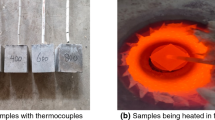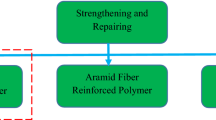Abstract
Concrete is a widely used building material, which is good in compression, but weak in tension. The poor tension properties of concrete are covered by using steel bars as reinforcement, which enable concrete to withstand almost all types of loads and provide ductility to structural members. However, it has some drawbacks, such as controlling multi-level cracking. It is widely accepted that using the different forms of fibres together is the only way to achieve strength, ductility, and resilience to control multi-level cracking of reinforced concrete. The novelty of this study is the development of the hybrid self-compacting fibre-reinforced concrete (SCC-FRC) with polyvinyl alcohol (PVA) and polypropylene (PP) fibres to eliminate the problems associated with steel fibres. This hybrid FRC can provide better crack controlling at all stages and enhancement in mechanical properties. Out of 14 mixes, one SCC mix (without fibres) served as a control mix. The rest SCC-FRC mix contained only 2% volume fraction of PVA fibres, 2% volume fraction of monofilament PP fibres, and 2% volume fraction fibrillated PP fibres of lengths 13, 19, and 25 mm, respectively, served as the benchmark for the hybrid mixes. The remaining six SCC-FRC mixes were hybrid and consisted of 1.5 and 0.5% volume fractions of PVA and PP fibres, respectively. Out of the six mixes, three included monofilament fibres measuring 13, 19, and 25 mm in length, while the other three had fibrillated fibres measuring 13, 19, and 25 mm in length. The fresh and hardened state properties of all mixes were determined by following EFNARC and ASTM standards. The hardened properties were determined by testing the specimens in compression, split tension, flexure, and direct tension. The test results showed that PVA and PP fibres as a hybrid significantly improved strength, ductility, and crack arrest.
















Similar content being viewed by others
References
544.1R-96 (2002) State of the Art Report on Fiber Reinforced Concrete Reported (Aci 544.1 R-96 Reapproved 2002)
"ACI Committee 544.3r-93. Guide for Specifying, Proportioning, Mixing, Placing and Finishing Steel Fiber Reinforced Concrete",
ASTM C 618 (2000), "Standard Specification for Coal Fly Ash and Raw or Calcined Natural Pozzolan for Use as a Mineral Admixture in Concrete", ASTM International
Abdul-Rahman, M, Al-Attar, AA, Hamada, HM, and Tayeh, B (2020), "Microstructure and Structural Analysis of Polypropylene Fibre Reinforced Reactive Powder Concrete Beams Exposed to Elevated Temperature", Journal of Building Engineering, 29, 101167
Afroughsabet V, Ozbakkaloglu T (2015) Mechanical and durability properties of high-strength concrete containing steel and polypropylene fibers. Constr Build Mater 94:73–82
Alani AM, Beckett D (2013) Mechanical properties of a large scale synthetic fibre reinforced concrete ground slab. Constr Build Mater 41:335–344
Al-Attar AA, Abdulrahman MB, Hamada HM, Tayeh BA (2020) Investigating the behaviour of hybrid fibre-reinforced reactive powder concrete beams after exposure to elevated temperatures. J Mater Res Technol 9:1966–1977
Asok, G, and George, S (2016), "Investigation on hybrid concrete using steel and polypropylene fiber", Int J New Technol Res, 2(5)
ASTM C 469 (2001), "Standard test method for static modulus of elasticity and Poisson’s ratio of concrete in compression.", ASTM
ASTM C39/C39M-12 (2012), "Standard test method for compressive strength of cylindrical concrete specimens", ASTM
ASTM C496/C496M-11 (2011), "Standard test method for splitting tensile strength of cylindrical concrete specimens",
ASTM C78–10 (2010), "Standard test method for flexural strength of concrete (using simple beam with third-point loading)",
Ayub T, Shafiq N, Khan SU (2015) Compressive stress-strain behavior of HSFRC reinforced with basalt fibers. J Mater Civ Eng 28(4):06015014
Balouch S, Forth J, Granju J-L (2010) Surface corrosion of steel fibre reinforced concrete. Cem Concr Res 40(3):410–414
Benson SDP, Karihaloo BL (2005) Cardifrc®-development and mechanical properties. Part III: uniaxial tensile response and other mechanical properties. Mag Concr Res 57(8):433
BIBM, and EFNARC (2005), "The European guidelines for self-compacting concrete"
Chen Y, Qiao P (2011) Crack growth resistance of hybrid fiber-reinforced cement matrix composites. J Aerosp Eng 24(2):154–161
Corinaldesi V, Moriconi G (2012) Mechanical and thermal evaluation of ultra high performance fiber reinforced concretes for engineering applications. Constr Build Mater 26(1):289
de Azevedo AR, Marvila MT, Tayeh BA, Cecchin D, Pereira AC, Monteiro SN (2021) Technological performance of açaí natural fibre reinforced cement-based mortars. J Building Eng 33:101675
De Schutter, G (2005), "Guidelines for testing fresh self-compacting concrete", European research project
Empelmann M, Teutsch M, Steven, G (2008), "Improvement of the post fracture behaviour of UHPC by Fibres", Editor "Book Improvement of the Post Fracture Behaviour of UHPC by Fibres", Kassel University Press GmbH, 177
Etli S, Cemalgil S, Onat O (2018) Properties of self-compacting mortars with different contents of synthetic macro fiber. Academic Perspective Procedia 1(1):593–602
Granju J-L, Balouch SU (2005) Corrosion of steel fibre reinforced concrete from the cracks. Cem Concr Res 35(3):572
Haido JH, Abdul-Razzak AA, Al-Tayeb MM, Bakar BA, Yousif ST, Tayeh BA (2021) Dynamic response of reinforced concrete members incorporating steel fibers with different aspect ratios. Adv Concrete Const 11(2):89
Holschemacher K, Höer S (2008), "Influence of PVA fibers on load carrying capacity of concrete with coarse aggregates". BEFIB 2008: 7th RILEM International Symposium on Fibre Reinforced Concrete 219–2292008
Holschemacher K, Höer S (2008), "Influence of PVA Fibers on load carrying capacity of concrete with coarse aggregates", Editor "Book Influence of PVA Fibers on Load Carrying Capacity of Concrete with Coarse Aggregates", Chennai, India, 219
Hsie M, Tu C, Song P (2008) Mechanical properties of polypropylene hybrid fiber-reinforced concrete. Mater Sci Eng, A 494(1–2):153–157
Jenq Y, Shah SP (1986) Crack propagation in fiber-reinforced concrete. J Struct Eng 112(1):19–34
Kaufmann J, Frech K, Schuetz P, Münch B (2013) Rebound and orientation of fibers in wet sprayed concrete applications. Constr Build Mater 49:15–22
Khan SU, Ayub T (2016) Modelling of the pre and post-cracking response of the PVA fibre reinforced concrete subjected to direct tension. Constr Build Mater 120:540–557
Khan M, Cao M, Ali M (2020), "Cracking behaviour and constitutive modelling of hybrid fibre reinforced concrete", J Building Eng 30: 101272
Kim DJ, Park SH, Ryu GS, Koh KT (2011) Comparative flexural behavior of hybrid ultra high performance fiber reinforced concrete with different macro fibers. Constr Build Mater 25(11):4144–4155
KM, Af, and Varghese, S, (2014) Behavioral study of steel fiber and polypropylene fiber reinforced concrete. Int J Res Eng Technol 2(10):17–24
Li, VC (2008), "Engineered cementitious composites (ECC) material, structural, and durability performance"
Li B, Chi Y, Xu L, Shi Y, Li C (2018) Experimental Investigation on the flexural behavior of steel-polypropylene hybrid fiber reinforced concrete. Constr Build Mater 191:80–94
Lim TY, Paramasivam P, Lee SL (1987), "Analytical model for tensile behavior of steel-fiber concrete", ACI Mater J, 84(4)
Naaman AE, Reinhardt HW (2006) Proposed classification of HPFRC composites based on their tensile response. Mater Struct 39(5):547
Neville AM, Brooks JJ (2010), "Concrete technology", Longman Scientific & Technical
Nuruddin MF, Khan SU, Shafiq N, Ayub T (2014), "Strength development of high-strength ductile concrete incorporating metakaolin and Pva fibers", The Sci World J, 2014
Parameswaran VS (1991) Fibre-reinforced concrete: a versatile construction material. Build Environ 26(3):301–305
Peyvandi A, Soroushian P, Jahangirnejad S (2013) Enhancement of the structural efficiency and performance of concrete pipes through fiber reinforcement. Constr Build Mater 45:36–44
Qian C, Stroeven P (2000) Development of hybrid polypropylene-steel fibre-reinforced concrete. Cem Concr Res 30(1):63–69
Said M, Abd El-Azim AA, Ali, MM, El-Ghazaly H, Shaaban I (2020), "Effect of elevated temperature on axially and eccentrically loaded columns containing polyvinyl alcohol (Pva) fibers", Eng Struct 204: 110065
Shah SP, Daniel JI, Ahmad SH, Arockiasamy M, Balaguru P, Ball CG, Ball HP Jr, Banthia N, Batson GB, Bentur A (1993) Guide for specifying, proportioning, mixing, placing, and finishing steel fiber reinforced concrete. ACI Mater j 90(1):94–101
Shi F, Pham TM, Hao H, Hao Y (2020), Post-Cracking Behaviour of Basalt and Macro Polypropylene Hybrid Fibre Reinforced Concrete with Different Compressive Strengths, Constr Build Mater, 262: 120108
Sivakumar A, Santhanam M (2007) Mechanical properties of high strength concrete reinforced with metallic and non-metallic fibres. Cement Concr Compos 29(8):603–608
Soe KT, Zhang Y, Zhang L (2013) Material properties of a new hybrid fibre-reinforced engineered cementitious composite. Constr Build Mater 43:399–407
Song P, Wu J, Hwang S, Sheu B (2005) Statistical analysis of impact strength and strength reliability of steel-polypropylene hybrid fiber-reinforced concrete. Constr Build Mater 19(1):1–9
Sukontasukkul P (2004) Tensile behaviour of hybrid fibre-reinforced concrete. Adv Cem Res 16(3):115–122
Tabatabaeian M, Khaloo A, Joshaghani A, Hajibandeh E (2017) Experimental investigation on effects of hybrid fibers on rheological, mechanical, and durability properties of high-strength SCC. Constr Build Mater 147:497–509
Tian H, Zhang Y, Ye L, Yang C (2015) Mechanical behaviours of green hybrid fibre-reinforced cementitious composites. Constr Build Mater 95:152–163
Wang S, Li VC (2003), "Tailoring of Pva fiber/matrix interface for engineered cementitious composites (ECC)"
Xiaochun Q, Xiaoming L, Xiaopei C (2017) The applicability of alkaline-resistant glass fiber in cement mortar of road pavement: corrosion mechanism and performance analysis. Int J Pavement Res Technol 10(6):536–544
Yokota H, Rokugo K, Sakata N (2008) JSCE recommendations for design and construction of high performance fiber reinforced cement composite with multiple fine cracks. In: High performance fiber reinforced cement composites. Springer, Tokyo, Japan
Yildizel SA, Tayeh BA, Calis G (2020) Experimental and modelling study of mixture design optimisation of glass fibre-reinforced concrete with combined utilisation of Taguchi and extreme vertices design techniques. J Market Res 9(2):2093–2106
Zeyad AM, Khan AH, Tayeh BA (2020) Durability and strength characteristics of high-strength concrete incorporated with volcanic pumice powder and polypropylene fibers. J Market Res 9(1):806–818
Zheng Z, Feldman D (1995) Synthetic fibre-reinforced concrete. Prog Polym Sci 20(2):185–210
Author information
Authors and Affiliations
Corresponding author
Rights and permissions
About this article
Cite this article
Khan, S.U., Ayub, T. Mechanical Properties of Hybrid Self-Compacting Fibre-Reinforced Concrete (SCC-FRC) Containing PVA and PP Fibres. Iran J Sci Technol Trans Civ Eng 46, 2677–2695 (2022). https://doi.org/10.1007/s40996-021-00652-5
Received:
Accepted:
Published:
Issue Date:
DOI: https://doi.org/10.1007/s40996-021-00652-5




